The Standard Model of Cosmology is also called the Concordance model, which means the currently accepted model. Another name for it is the Lambda-CDM model, where Lambda is the cosmological constant, and CDM is an acronym for cold dark matter. In a nutshell, the Standard Model of Cosmology says the universe started with the Big Bang, which was followed by a very rapid expansion called inflation. After this came the formation of photons and leptons plus other particles, then hydrogen and helium, then stars and galaxies and planets. It is said that this will be followed by a heat death period dominated by black holes which eventually evaporate, maybe followed by a Big Rip. Note that the expansion of the universe is said to have slowed down after inflation, and is now thought to be speeding up again:
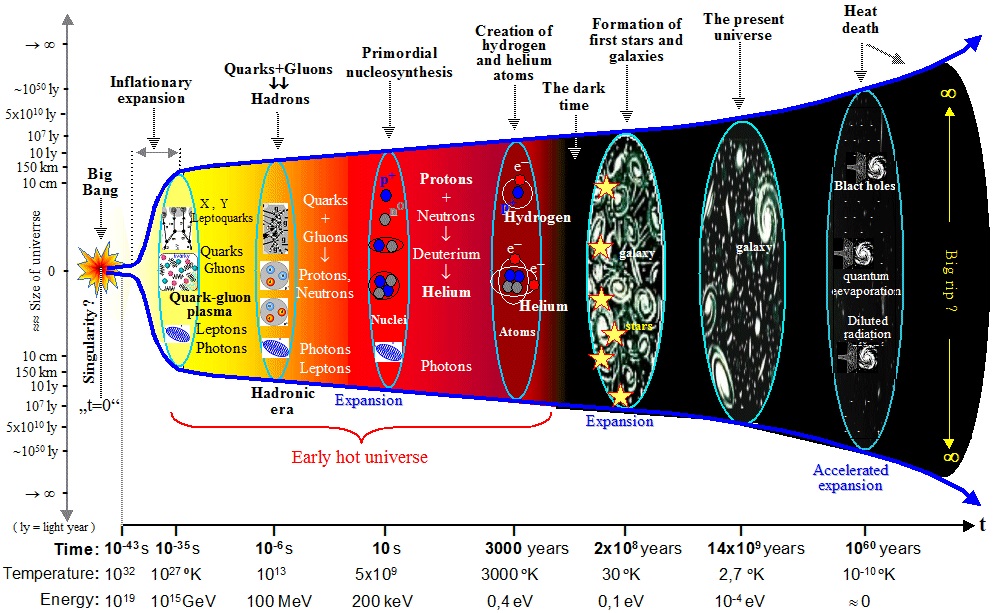 Image from astronuclphysics.info. Caption: A brief schematic diagram of the origin and evolution of the universe according to the standard cosmological model ΛCDM.
Image from astronuclphysics.info. Caption: A brief schematic diagram of the origin and evolution of the universe according to the standard cosmological model ΛCDM.
It all sounds familiar, but I think the Standard Model of Cosmology is wrong on multiple counts. I’ve come to that conclusion after reading a great number of papers and articles, both old and new. You can find hyperlinks to many of them in my various posts on gravity and cosmology. Apologies if some don’t work any more. Link rot is the bane of my life, and I don’t want to host papers and articles myself in case of legal problems. Please let me know if you find any bad links and I’ll try to fix them.
The James Web Space Telescope captured images of massive early galaxies which should not have been there
Anyway, I’m not the only one who thinks there are issues with the Standard Model of Cosmology. See for example the September 2003 New York Times article by astrophysicist Adam Frank and theoretical physicist Marcelo Gleiser. It was called The Story of Our Universe May Be Starting To Unravel. It’s paywalled, but David Gottlieb has a copy on his blog, and there’s also a copy on a website called Portside. Adam Frank also wrote 6 cracks suggest the standard model of cosmology is wrong. In addition the Royal Society held an event called challenging the standard cosmological model. This was a two-day discussion meeting in April 2024 which talked about things like the Hubble tension and Anomalous Bulk Flows. Also see articles like Marc Airhart’s April 2023 piece entitled James Webb Space Telescope Images Challenge Theories of How Universe Evolved. Like I was saying last time, the James Web Space Telescope captured images of massive early galaxies which shouldn’t have been there. However Marc Airhart also wrote the press release I mentioned last time. It was an August 2024 item called Early Galaxies Were Not Too Big for Their Britches After All. I described the associated paper as “circling the wagons” to defend the Standard Model of Cosmology, which I think is a mistake. Science is all about experiment and observation and progress, not defending an orthodoxy.
The FLRW metric starts with the assumption of homogeneity and isotropy of space, which is a big mistake
So, what do I think is wrong with the Standard Model of Cosmology? First and foremost, it employs the Friedmann–Lemaître–Robertson–Walker metric, which is usually abbreviated to the FLRW metric. The FLRW metric “starts with the assumption of homogeneity and isotropy of space”, which is a big mistake. I say that because Einstein said a gravitational field was a place where space is “neither homogeneous nor isotropic”, and because gravitational fields are ubiquitous throughout the universe. Since the Standard Model of Cosmology is said to be, in part, “based on Einstein’s general relativity”, the assumption of homogeneity and isotropy is pretty disastrous. All the more so because Einstein also said “the energy of the gravitational field shall act gravitatively in the same way as any other kind of energy”. I’ll come back to that.
Ω is said to determine whather the geometry of the universe is spherical, saddle-like, or flat
Meanwhile another big mistake in the FLRW metric is the density parameter Ω (omega). This started life as a matter density. It nowadays includes dark matter and dark energy, but the same principle applies. The moot point is that Ω is said to determine whather the geometry of the universe is spherical, saddle-like, or flat. Keeping it simple, if Ω is greater than 1, the geometry of the universe is said to be spherical, with a positive curvature. If Ω is less than 1, the geometry of the universe is said to be saddle-like, with a negative curvature. If Ω is exactly 1, the geometry of the universe is said to be flat, with no curvature:
 Image from Skidmore College Introduction to General Relativity section 7.2, based on a Wikipedia image by NASA
Image from Skidmore College Introduction to General Relativity section 7.2, based on a Wikipedia image by NASA
It’s a big mistake because if space is homogeneous, there’s no gravitational field, so light goes straight, so the universe is flat. Unfortunately most cosmologists don’t know this, so they scratch their heads wondering why Ω is exactly 1. Like we’re living in some Goldilocks universe. But it just doesn’t matter what the density is. If the universe is flat today, it’s flat tomorrow and vice versa. Ad infinitum. Which means Ω doesn’t matter. It’s got to go.
A gravitational field is not a place where space is curved
As to why that big mistake is there, perhaps it’s due to another. See the Wikipedia article on the shape of the universe. Note the line that says this: “General relativity explains how spatial curvature (local geometry) is constrained by gravity”. No it doesn’t. A gravitational field is not a place where space is curved. A gravitational field is a place where spacetime is curved. That’s because the inhomogeneity of space diminishes, in a non-linear fashion, with distance from the central star or planet. Because of this, the “force” of gravity varies with elevation, resulting in a tidal force. If there’s no detectable variation in the inhomogeneity of space, there will be no detectable tidal force and so no detectable spacetime curvature. But light will still curve downwards. This is why light doesn’t follow the curvature of spacetime, Einstein never said that. Instead he said it curves downward due to a refraction. He even mentioned Huygens, and we don’t talk of gravitational lensing and Einstein’s rings for nothing. See the Baez preliminaries article dating from 2006: “Similarly, in general relativity gravity is not really a ‘force’, but just a manifestation of the curvature of spacetime. Note: not the curvature of space, but of spacetime. The distinction is crucial”. Unfortunately Alexander Friedmann’s 1922 paper on the curvature of space* did not make that crucial distinction.
A gravitational field alters the motion of matter and light through space, but it won’t make space fall down
It gets worse, because Ω is also said to determine the fate of the universe. If Ω is greater than some critical value, it is said that the expansion of the universe will eventually be halted by gravity, and the universe will collapse:
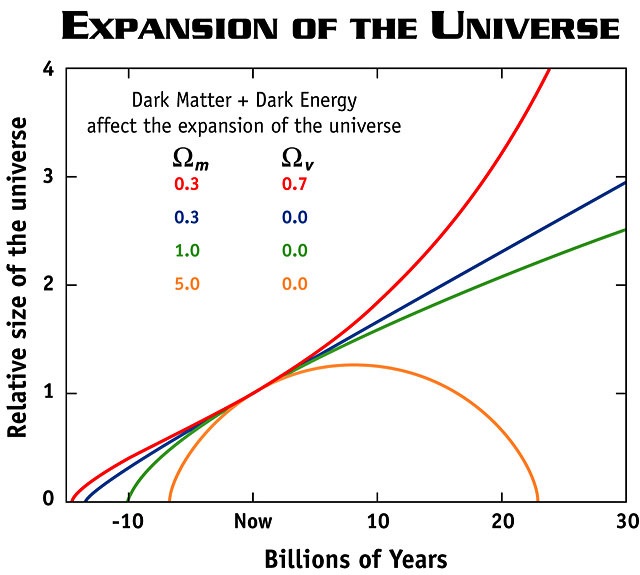 Expansion of the universe image from NASA’s WMAP fate of the universe web page
Expansion of the universe image from NASA’s WMAP fate of the universe web page
See John Peacocks’s cosmological physics for more: “This is marvelously simple: the dynamics of the entire universe are the same as those of a cannonball fired vertically against the Earth’s gravity”. Only they aren’t, because it’s space that’s expanding, and because homogeneous space means there’s no overall gravitational field. Even if there was an overall gravitational field, a gravitational field alters the motion of matter and light through space, but it won’t make space fall down. So it won’t stop the expansion of space. We do not live in some Chicken-Little universe where the sky is falling in.
A gravitational field is not negative energy
Peacock also said the Friedmann equation says a universe that is spatially closed has negative total energy. The trouble with that, is that it presumes gravitational field energy is negative. It isn’t, it’s positive. That’s why Einstein said “the energy of the gravitational field shall act gravitatively in the same way as any other kind of energy”. Again I’ll come back to that. Sadly even people like Stephen Hawking didn’t know this. Hence on page 82 of his 2002 book The Theory of Everything he said this: “in a sense the gravitational field has negative energy”. No it doesn’t. People only think this because they follow a convention that sets gravitational potential energy to zero at infinity. When you know how gravity works, you know it’s another big mistake. When you drop a brick, gravity converts some of the brick’s potential energy, which is E=mc² mass-energy, which is internal kinetic energy, into external kinetic energy. Once the brick hits the ground this kinetic energy gets dissipated, and you end up with a mass deficit. At no point was there any actual negative energy anywhere.
The FLRW metric is a waste of time and space
Friedmann didn’t know this either. Moreover during the first world war he was a ballistics instructor on the Austrian front – see Ari Belenkiy‘s Alexander Friedmann and the origins of modern cosmology. This is why Friedmann modelled the expanding universe as something like a cannonball fired aloft. When all you have is a hammer, everything looks like a nail. Even when it isn’t. For the cherry on top, note that the Wikipedia article on the Friedmann–Lemaître–Robertson–Walker metric says this: “the general form of the metric follows from the geometric properties of homogeneity and isotropy; Einstein’s field equations are only needed to derive the scale factor of the universe as a function of time”. Which means Einstein’s field equations are being used in a situation where there is no gravity. So the FLRW metric is a waste of time and space. It’s got to go too.
Lambda is said to be the cosmological constant
Another issue with the Standard Model of Cosmology, which again is known as the Lambda-CDM model, is the lambda. Lambda is said to be the cosmological constant, which is associated with dark energy. This has a considerable history, but in brief, Einstein added it to General Relativity in 1917 as a kludge to counteract the gravitational attraction of all the matter in the universe. He thought the universe was static. When in 1931 he learned from Edwin Hubble that the universe was expanding, he ditched the cosmological constant, saying it was his greatest blunder. Don Lincoln wrote an article about it, saying “this was considered the state of the art for nearly 70 years”. That was until 1998, when cosmologists found that the expansion of the universe was accelerating, not decelerating like they expected. There’s a subtlety here that most people don’t appreciate. Dark energy is said to be responsible for the accelerating expansion of the universe, but not the expansion of the universe. So what’s causing the expansion of the universe? That’s a gap in the Lambda-CDM model. Google on what causes the expansion of space? and you will find Fraser Cain telling you that it’s “mostly momentum left over from the Big Bang”. That’s lies to children because it’s space that’s expanding. If you put quotes round the question you don’t even get that.
Schrödinger’s cosmic pressure
What you won’t find is Erwin Schrödinger’s cosmic pressure. See the 2014 Cambridge companion to Einstein by Michel Janssen and Christoph Lehner: “Schrödinger [1918] had pointed out another way of treating the cosmological constant: moving it from the left-hand side of Equation [7], where it represents a contribution to space-time curvature, to the right-hand side, where it represents a contribution to the energy-matter distribution. Then it would correspond physically to a kind of cosmic pressure”. See Alex Harvey’s 2012 paper How Einstein Discovered Dark Energy for a translation of Schrödinger’s paper. Also see the 2010 paper by Ramesh Gupta and Anirudh Pradhan: Is Hubble’s Expansion due to Dark Energy? I think the answer is yes. I think dark energy is responsible for both for the expansion of space, and the accelerating expansion of space, because it’s a kind of cosmic pressure, acting against what Mordehai Milgrom referred to as the strength of space. To get a handle on it, I think the balloon analogy is pretty good, provided you forget about outlandish notions of higher-dimensional curvature and a universe with no centre and no edge:
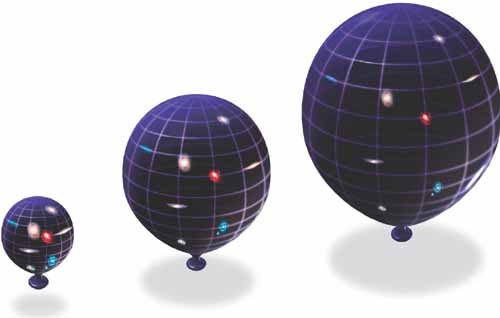 Balloon analogy image from the Charles Lineweaver and Tamara Davis SciAm.article Misconceptions about the Big Bang
Balloon analogy image from the Charles Lineweaver and Tamara Davis SciAm.article Misconceptions about the Big Bang
When you inflate a balloon, the pressure of the air inside makes the balloon expand. However if it’s a bubblegum balloon and it’s in a vacuum, the skin gets thinner and weaker so the balloon expands all the more. Faster and faster. What’s not to like?
Lambda is another one that’s got to go
This wider idea of dark energy might sound unfamiliar, but it’s in line with what Einstein said in Nottingham in 1930: “the strange conclusion to which we have come is this – that now it appears that space will have to be regarded as a primary thing and that matter is derived from it, so to speak”. We’re all familiar with the E=mc² idea that matter is made of energy, but not so familiar with what Einstein was saying: that space itself is energy. I think he was right about that, because I’ve looked into things like the electron and what energy is, and because in 1929 Einstein also said a field is a state of space. Check out does matter differ from vacuum? by Christoph Schiller. The answer is no. So I think it’s a pity that Einstein didn’t like Schrödinger’s cosmic pressure, and didn’t use it in the expanding Einstein-de Sitter universe in 1932. But we are where we are. Which is that dark energy can’t be a cosmological constant. Conservation of energy is surely telling us that, and Einstein did ditch it after all. So lambda is another one that’s got to go.
Quintessence
For myself I’d be happy to replace lambda with quintessence. In his 1920 Leyden address, Einstein referred to space as the aether of general relativity. Since his stress-energy tensor includes a shear-stress term, it would seem that space is some kind of gin-clear ghostly elastic. So much so, that the space of the universe is akin to compressed elastic. Hence it expands, like a stress-ball expands when you open your fist. That works for me, especially since I’ve read the Robert B Laughlin quote likening Einstein’s aether to the modern concept of the vacuum.
Cold dark matter particles have got to go too
What doesn’t work for me is the cold dark matter. It was proposed in 1982 by James Peebles. That’s 42 years ago, and nobody has ever seen any WIMPs or axions or any of the other dark matter candidates. Why are people so blinkered about this? Perhaps it’s because cosmologists defer to particle physicists, and when all you have is a hammer, everything looks like a nail. If they didn’t, and if they read the Einstein digital papers, they might make a connection. That’s the connection between 1) a gravitational field is a place where space is “neither homogeneous nor isotropic” and 2)“the energy of the gravitational field shall act gravitatively in the same way as any other kind of energy”. Especially if they dropped the FLRW “assumption of homogeneity and isotropy of space”. Then they’d be staring at some low-hanging fruit called inhomogeneous space. Space where the energy density varies:
 Dark matter 3D map, image credit NASA, ESA and R. Massey (California Institute of Technology), see spacetelescope.org
Dark matter 3D map, image credit NASA, ESA and R. Massey (California Institute of Technology), see spacetelescope.org
Take a region of high density space and put it inside a bigger region of low-density space. What are you going to see? A density gradient between the two called a gravitational field. That would give you your dark matter for free. Especially since as per the raisin-cake analogy, space expands between the galaxies but not within, and conservation of energy tells you that the spatial energy density must be lower between the galaxies. So every galaxy is embedded in a region of high-density space in a bigger region of low-density space. People have written about inhomogeneous vacuum, but it’s never gained any traction, more’s the pity. All in all I think cold dark matter particles have got to go too, to be replaced by inhomogeneous space. Space is cold, it’s dark, and it’s matter of sorts. So it will do fine. Next.
Inflation has definitely got to go
Next for the chopping block is inflation. That’s because inflation is a solution to problems that don’t exist. The first problem is the monopole problem, which misses the point that the electron has an electromagnetic field, not an electric field. It’s as if cosmologists don’t understand what Maxwell was talking about with the screw nature of electromagnetism, or what charge is, or why Maxwell’s unification means magnetic monopoles do not exist. The second problem is the flatness problem, which is the magical mysterious Ω = 1 again. It misses the point that homogeneous space is space without a gravitational field. The third problem is the horizon problem, wherein the CMB temperatures are almost identical in different directions. It misses the point that as Stephen Hawking said, the universe can be likened to a black hole in reverse. Then since a black hole is a place where the “coordinate” speed of light is zero, and since matter can’t move faster than light, nothing moves, so there is no temperature, and there are no differences. Note that the Wikipedia article on inflation says “the detailed particle physics mechanism responsible for inflation is unknown”. That’s because it’s a fairy tale. Inflation has definitely got to go.
Einstein’s variable speed of light
Everything I’ve spoken about so far has been something that needs throwing out of the Standard Model of Cosmology. However there’s one thing that’s missing. There’s a mention of it in the the Wikipedia article on the horizon problem. That says “the most commonly accepted solution is cosmic inflation. Different solutions propose a cyclic universe or a variable speed of light”. There’s a Wikipedia article on the variable speed of light. Only there’s something missing from that too. You can however find it in an older version of the article. It’s Einstein’s variable speed of light:
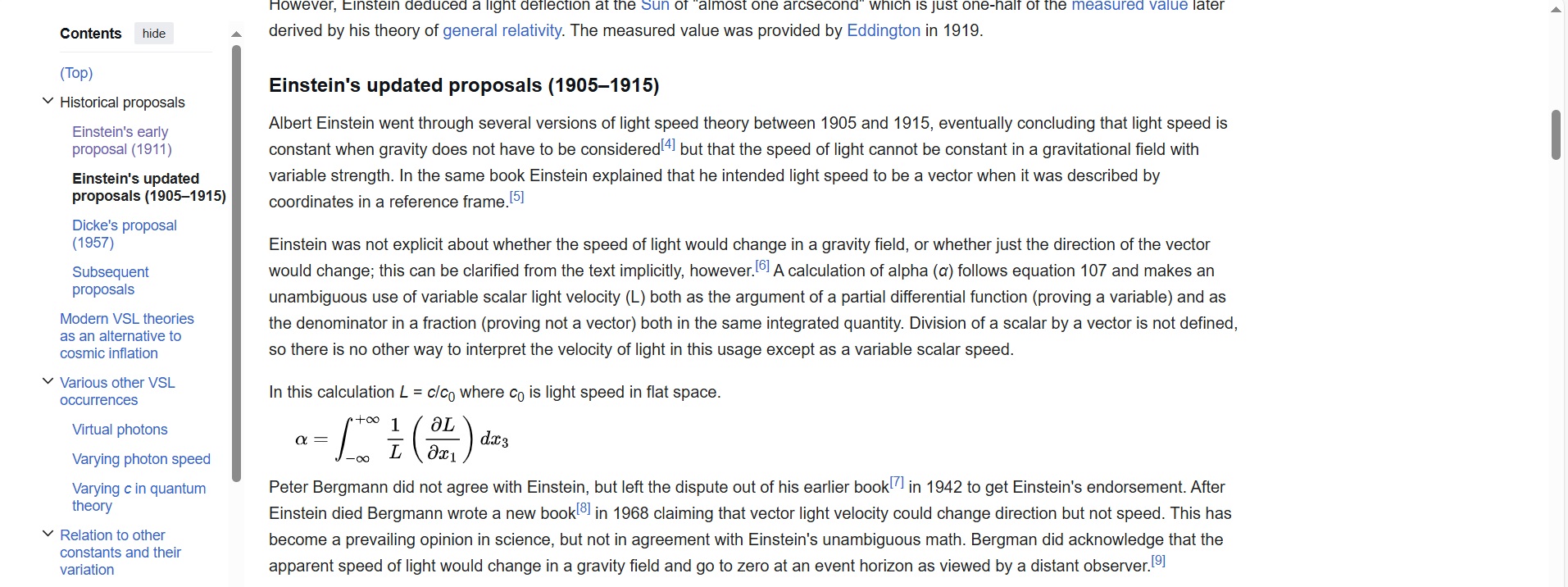 Screenshot from Wikipedia
Screenshot from Wikipedia
In 1905 when he was doing special relativity, Einstein said the speed of light is constant. However by 1907 when he was doing general relativity, he said the speed of light is not constant, and instead varies with gravitational potential. He also said it in 1911, in 1912, in 1913, in 1914, in 1915, in 1916, and in 1920. He never ever stopped saying it. He made it crystal clear that “a curvature of rays of light can only occur in a place where the speed of light is spatially variable”. You can find Irwin Shapiro saying much the same thing in 1964: “according to the general theory, the speed of a light wave depends on the strength of the gravitational potential along its path”. Also see what Don Koks the PhysicsFAQ editor said in 2014: “light travels faster near the ceiling than near the floor”. The speed of light varies in the room you’re in. If it didn’t, light wouldn’t curve and your pencil wouldn’t fall down.
The Big Bang might have happened more than 13.8 biillion years ago
I think there’s unequivocal evidence for this in the NIST optical clocks. An optical clock goes slower when it’s lower because light goes slower when it’s lower. This is of crucial importance, especially since in his 1939 black hole paper Einstein said light rays “take an infinitely long time (measured in “coordinate time”) in order to reach the point r = μ/2”. That point is the event horizon, and this is of crucial importance because as Hawking said, the universe can be likened to a black hole in reverse. Thus we can expect the early dense universe to be subject to intense time dilation. Hence the Big Bang might have happened more then 13.8 biillion years ago.
I don’t favour tired light
However that doesn’t mean I agree with Rajendra Gupta. See David Szondy’s New Atlas article Tired light might make the universe twice as old as we thought. Also see JWST early Universe observations and ΛCDM cosmology in Monthly Notices of the Royal Astronomical Society. I’ve never liked tired light. As to why, see page 149 of Relativity, the Special and General Theory. Einstein said “an atom absorbs or emits light at a frequency which is dependent on the potential of the gravitational field in which it is situated“. When a photon ascends, its energy does not reduce, and nor does its frequency. The photon doesn’t get redshifted at all. Instead the photon was emitted at a lower frequency at a lower elevation. Conservation of energy applies. It appears to have less energy at the higher elevation because that’s where optical clocks go faster, along with everything else. So we measure the photon frequency to be reduced, even though it didn’t change on the way up. I think the same applies to the CMBR photons**. People say they’ve been redshifted a thousandfold, but conservation of energy tells me they haven’t. It would seem that cosmologist Tamara Davis thinks the same. See the Scientific American article Is the Universe leaking energy? It would seem that the answer is no, and that there’s a doppler shift in play:
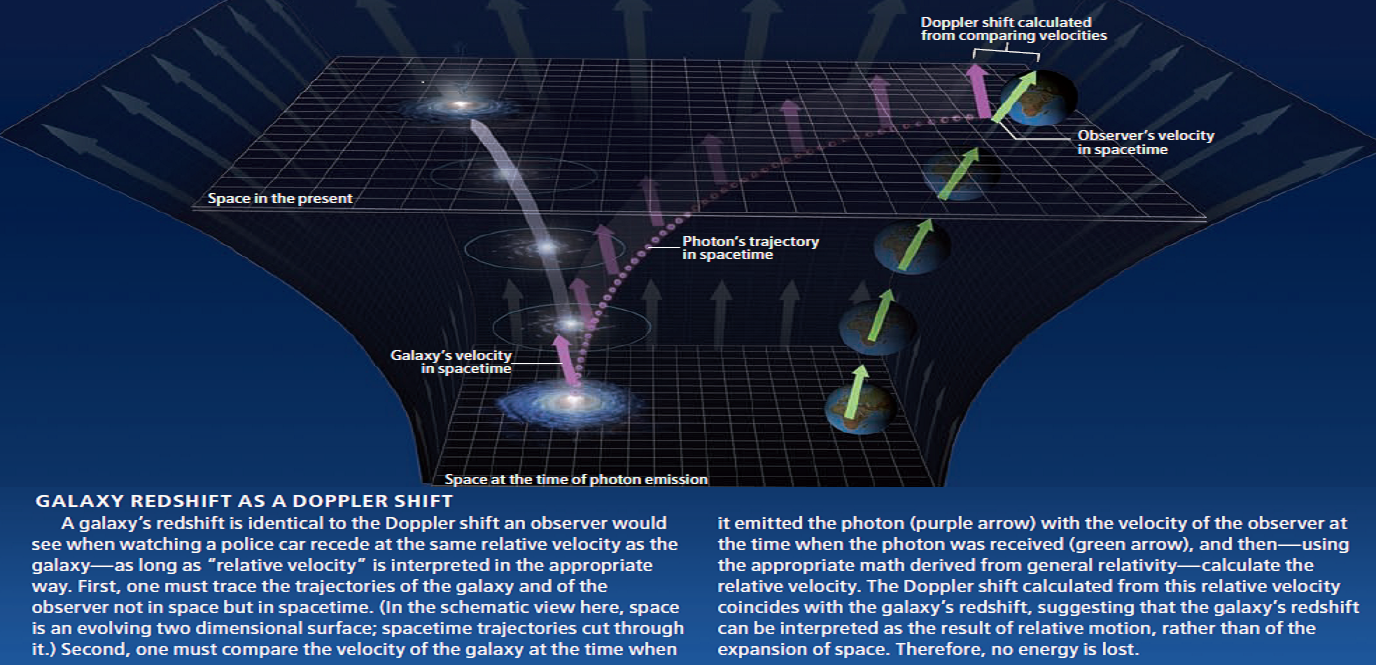 Image by Tamara Davis and Scientific American, see Is the Universe leaking energy?
Image by Tamara Davis and Scientific American, see Is the Universe leaking energy?
So if I don’t think the CMBR photons lose energy, I don’t think any other photons lose energy either, not when they’re merely moving through space. Hence I don’t favour tired light. Gupta does mention a variable speed of light and “covarying coupling constants”, and I’ve previosuly talked about the fine structure constant varying with gravitational potential. So I don’t think he’s all wrong. I do however think he’s wrong when he says the universe is 26.7 billion years old. That’s because I have a nasty sneaking suspicion that the universe is a lot older than that.
The Standard Model of Cosmology is wrong on multiple counts, but it can be fixed
However I can’t prove it, nor can I support my suspicion that the Big Bang happened very slowly because of time dilation. Nor can I elaborate on the $64,000 question, which is what banged? I have always loved The Last Question by Isaac Asimov, but I have never loved creation ex nihilo. Instead I wonder at the vastness, and I wonder whether the universe was once a vast black hole that somehow broke up into supermassive black holes along with space full of radiation. I have a suspicion about the mystery of the missing antimatter wherein baryon asymmetry is matched by lepton asymmetry, and the proton is the antimatter. I have a suspicion that the universe, not just the observable universe, was once the size of grapefruit. Newton’s infinite universe cuts both ways, so because the universe is expanding, I suspect it’s finite and has some kind of edge. I can’t prove this, it’s where I hit the buffers and have to call it a day. Misconceptions abound, I am not immune from them. In addition I think Big Bang cosmology is much more difficult than particle physics where there’s experimental evidence instead of fossil evidence. But I hope that ditching Ω and the FLRW metric along with the homogeneous space, the higher-dimensional curvature, the zero-energy universe, lambda, cold dark matter particles, and inflation helps tidy things up a little. The Standard Model of Cosmology is wrong on multiple counts, but it can be fixed.
* By the by, I think the strong curvature regime is electromagnetism.
** Fun fact: when the CMBR was discovered in 1965, it was described as evidence for the Big Bounce. The two famous back-to-back papers were A Measurement of Excess Antenna Temperature at 4080 Mc/s by Penzias and Wilson, and Cosmic Black-Body Radiation by Dicke, Peebles, Roll, and Wilkinson. I am not a fan of the Big Bounce.
Test. To be deleted.
Test receivedBoss. I can’t comment much right now, I need to keep reading as many of those links as I can first.
But I will say that you sold me on Quintessence the first time you mentioned it in an earlier article/ response.
Good stuff Greg, thanks. Quintessence, the aether, the fifth element. But in truth it’s the first element, and the only element, because all other elements are made from it. Yeah!
But the more pressing issue is : what fresh new hell has the E.U. & Brxit accomplished with this ungodly new tax on beer’s 🍻 alcohol content? Now they are watering down all the sud’s to only 3.5% content ? Blasphemy I say, sheer madness at best !
Therefore check your PayPal for a wee bit of tax relief funds for a wee dram of ” No E ” wisky.
Many thanks Greg. I shall use it wisely. As for the tax by alcohol content, I’d best not start. Grrrr.
Hey Boss, when you stated that when you put a smaller sized high density field inside a larger low density field: the result is a pressure gradient of possibly shifting, merging fields and this could be interpreted as dark energy controlled by gravity ?
Could this gradient also be interpreted as a heat gradient as well and be contrued with the 2nd Law of Thermodynamics?
Still busy reading up on the fascinating research byDr. Schiller & Team and other rabbit hole links.
Hey Boss, when you stated that when you put a smaller sized high density field inside a larger low density field: the result is a pressure gradient of possibly shifting, merging fields and this could be interpreted as dark energy controlled by gravity ?
Could this gradient also be interpreted as a heat gradient as well and be construed with the 2nd Law of Thermodynamics?
Still busy reading up on the fascinating research by Dr. Schiller & Team and other rabbit hole links.
It could be interpreted as dark matter, Greg, rather than dark energy. If you could somehow remove the Earth whilst keeping the space around it exactly as it was, it would look like dark matter because “the energy of the gravitational field shall act gravitatively in the same way as any other kind of energy”. It’s like it’s s lump of denser space in less-dense space.
.
The gradient couldn’t be interpreted as a heat gradient, because all you’ve got is cold dark empty space.
Dear Physics Detective,
Thank you for your excellent publications. I am personally rejecting Big Bang too, but not because of something wrong with GR, rather something wrong with interpretation of the red shift. The classical tired light theory is not possible – the photons losing the energy in one interaction like Compton will make blurred even the close galaxies (see here):
https://vixra.org/pdf/2311.0060v1.pdf
But if the light is allowed to have multiple very tiny scatterings the situation changes dramatically – in this case the light will be dissipating energy proportional to number of encounters N but scattered only proportional to sqrt(N) (imagine it like a diffusion-like process). In this case the close galaxies were as clear as no light scattering is present but far galaxies (Z higher than 10) will be blurred indeed (exactly what James Webb Space Telescope sees). This phenomenon is easily confirmed on supernovas (standard objects):
https://vixra.org/pdf/2406.0162v1.pdf
or here:
https://tipikin.blogspot.com/
It makes strong hint that the photons have some unusual properties which are responsible for red shift and not space-time.
In general the modern physics is in a huge crisis, see my books on Vixra or Researchgate:
https://www.researchgate.net/publication/353523212_The_quest_for_new_physics_An_experimentalist_approach
https://www.researchgate.net/publication/366067523_The_quest_for_new_physics_An_experimentalist_approach_Vol2_The_second_book_on_the_topic_with_emphasis_on_certain_ideas
That sounds interesting Dmitriy. I will check it out. Meanwhile can I say that IMHO It’s sad that you have ideas like this, but you have to publish them on vixra. Especially so because there are some very wrong ideas which have the full weight of the scientific establishment behind them.
Dmitriy,
Like current Big Bang dogma, the Hubble Constant and the Doppler effect are not good fits with a lot of the evidence. Like with the current photon 😉 (The Photon Current – 14).
Dredd, can I make it clear that I don’t think the ascending photon redshifts at all. As Einstein said, the photon is emitted at a lower frequency at a lower elevation. It doesn’t lose energy on the way up. Also, I don’t think the CMBR photons have redshifted. See the Tamara Davis Sci-Am article I referred to in the post.
Dear Physics Detective,
Thank you for your comment. Of course my books are published on Vixra and on Morebooks too (despite it is the publication at my own expense, they are relatively cheap compare to others). The third book is in process of writing, because the supernova demostrated light scattering so early, I am changing it a little from pure speculative to somewhat more evidence supported. However, from my experience the websites like Researchgate (free publication of pre-prints) and Academia.edu (also free publication of preprints) are generating more interest among scientists. Researchgate is especially good because they have a lot of ongoing discussions on the “hot” topics and Big Bang, Dark Matter, Dark energy, galactic Red Shift are very popular.
Good luck with your work Dmitriy. I have paricipated in discussions on Researchgate, and hope to participate in many more.
Dear Dr. Tipikin, this might be the only chance to ask a real PhD. Physicist my #1 stumper of a question.
What function does the mostly ignored, lowly little Neutrino do inside a nucleus? Does it exist whole pre-expulsion? Is it created as a by waste product ?
My layman’s guess is that it acts simular to a bushing/ball bearing internal lubricant ? This only works if the S.M. is completely abandoned and replaced with Quantum Knot Theory.
It looks like he isn’t answering, Greg. If I might offer a little something: IMHO the neutrino does not exist whole pre-expulsion. IMHO it is created as a by-product. IMHO it acts similar to a twist in a knot. In electron capture a neutrino is emitted. In the opposite process, beta decay, an antineutrino is emitted. Twist, untwist.
.
By the by, I think the Standard Model of Particle Physics should be completely abandoned. Maybe I should write about that.
“Maybe I should write about that.” – The Physics Detective
Indeed!
Here ! Here ! Definitely write a long, glowing, fact filled eulogy for the S.M. !
R.I.P. you filthy buggers…..
Your concepts are always math & fact based, first & foremost Boss. Mine are obviously, mostly whimsical flights of non- math based fantasies
Dear Greg,
Thank you for your question. From my perspective there are many things to be discovered before the real hypothesis of the origin of Universe may be coined. I agree with young Einstein – universe is static. Reddening of light is indeed tired light due to some very tiny friction like interactions (not yet discovered on Earth). The heat death of Universe (all the matter goes into black holes and neutron stars and energy) is strongly exaggerated (see my idea of energy-matter cycle with some of the nuclear processes already well researched involved).
https://tipikin.blogspot.com/2022/04/energy-matter-cycle-aka-water-cycle-on.html
As far as Standard Model – I am sure it will become part of a more general idea similar to Newton physics may be derived as particular case of either Einstein or Schrodinger theory.
Dmitiry: I note this on you blog post: “Why matter predominate – it is a very good question in this picture of Universe, but as unsolvable as it is with Big Bang hypothesis – it is merely not enough knowledge now to answer it”. You might want to take a look at The mystery of the missing antimatter. I think the electron is matter, and the positron is antimatter. But I also think the antiproton is matter, and the proton is antimatter.
https://www.eldiario24.com/en/magnetohydrodynamic-motor-navy-ships/3148/
This article definitely needs your expert analysis, I found it be fascinating. I want one for my collection of X-Ray guns 😫!
Greg: I read the article, but didn’t learn much. There weren’t any details. I will have a dig around and get back to you.
Not quantum physics Boss, but another interesting IT/computer/biology article:
https://www.sciencealert.com/a-first-of-its-kind-signal-has-been-detected-in-human-brains
Interesting stuff, Greg. Especially this: “This is the logical underpinnings of our brain – ripples of voltage that can be communicated collectively in two forms: either an AND message (if x and y are triggered, the message is passed on); or an OR message (if x or y is triggered, the message is passed on)”. I didn’t know our heads were full of AND gates and OR gates.
Makes sense why I get stuck in mental loops all the time……..I suffer from stuck gates !
It also can be contrued as our brains are a complex 3-D web of electron flow between microscopic anodes & cathodes made of living tissues ?
… or bill gates …
😅😂🤣
Another historical article on gravitational redshift: https://articles.adsabs.harvard.edu/cgi-bin/nph-iarticle_query?bibcode=1980QJRAS..21..246H&db_key=AST&page_ind=0&plate_select=NO&data_type=GIF&type=SCREEN_GIF&classic=YES
.
Makes me wonder why Einsteins early prediction of bending was off by half but redshift was spot on.
Thanks Steve. I see it, the hyperlink was interrupted in your comment. And in mine too – I had to go into the WordPress to fix it. Perhaps the bending was off by half but redshift spot on because the latter only depends on the time dilation, Note that your second link says this: “The existence of the gravitational redshift effect, however, follows from the equivalence principle alone, so it is not a test of general relativity per se”. It also says this: “In 1915, however, Einstein realized that space curvature doubles the size of the effect”. PS: space is not curved in a gravitational field, it’s inhomogeneous, and denser, hence “The problem is only partly due to the fact that the gravitational field carries energy and thus ‘attracts itself'”. I think it’s conceptually straightforward once you appreciate that an atom is 99% empty space is wrong by 1%.
A mention that gravity carries its own energy, attracts itself,:
https://einstein.stanford.edu/SPACETIME/spacetime3.html
.